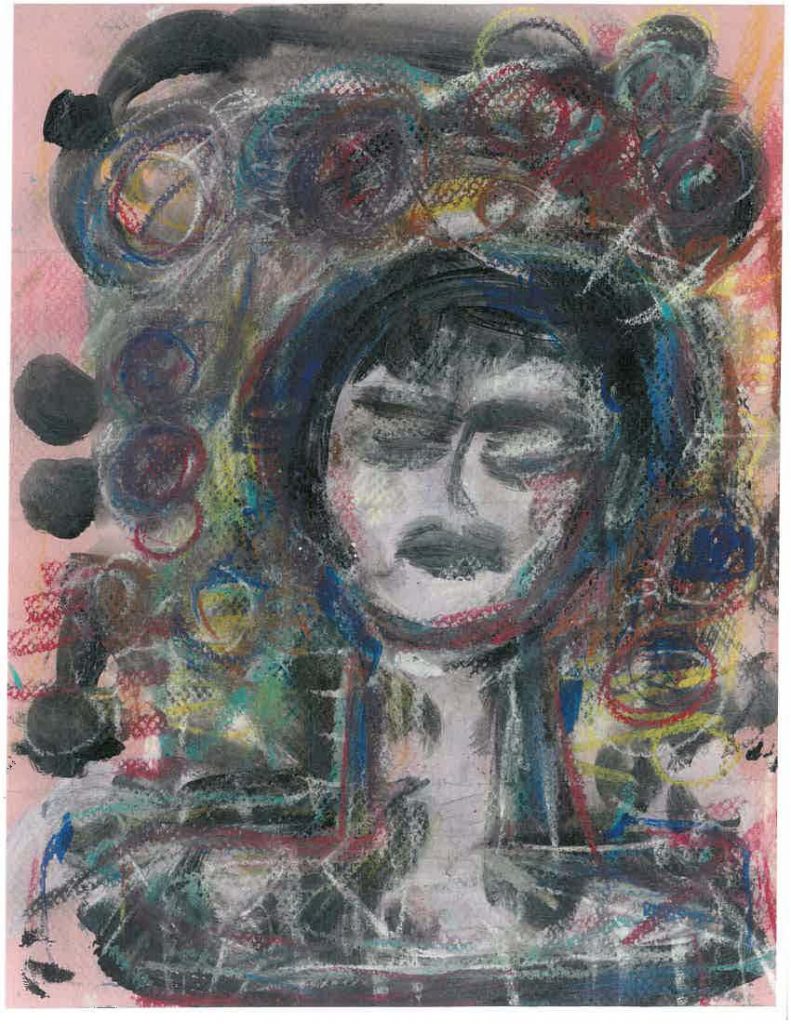Nonfiction by Beth Aviv from our Spring 2013 issue.
I have been transposing Cay Bahnmiller’s letters from handwriting to print. I’m rereading and typing letters she wrote me between 2005 and 2007, after I’d moved from Detroit to New York and before she died. All told, I’ve typed thirty single-spaced pages from a five-inch stack of letters that often arrived in hand-painted envelopes beautiful enough to frame. And that doesn’t count the paintings, sketches, and bouquets of dried flowers I’ve saved in Ziploc bags. In her handwritten letters I hear her voice—so sweet and so vicious.
Cay was an artist who made her life in Detroit after graduating from the University of Michigan with a BFA in 1976. I got to know Cay in the early nineties following the funeral of a mutual friend who had died of AIDS. I became a modest patron and she became one of my dearest friends. My favorite times were our lunch dates to the Atlas Globe on Woodward or the Russell Street Deli in Eastern Market. Our conversations were gossipy and dense. After I moved to New York (and covered the walls of my studio apartment with her paintings), we spoke often on the phone and wrote letters. She never did get herself a computer or an e-mail address.
As I transcribe her letters, I wonder what to do about her odd use of grammatical mechanics. To remain true to her intentions and insinuations, I must decide if and when to punctuate. Do I destroy her meaning or enhance it when I add the logical comma? Did she purposefully leave off a period or was she careless? She was too smart not to know. In any case, that period—missing or not—matters. For example, in December 2006, a month before her unexpected death from an overdose of psychotropic drugs and vodka, she left off a period and started a new thought on the next line. How do I convey in type the essence of that lost period, that vacant pause?

I simply cannot live on pills + in a decimated city
Having no employment is simply a slow death.
I choose to go to a new line, as W.S. Merwin might to signify a break in thought, or as Denise Levertov might to force a half pause. And what about the plus sign? Would an ampersand make more sense or should I type out the word and? And what of the word employment that is really spaced as emp l o y ment? How do I reproduce spacing that reveals how upset she was about not selling her work or getting calls to cater?
Or what about the lack of capitalization? She starts her letters dear Beth. My computer wants to autocorrect and capitalize dear. Should I let it? Some words are entirely in caps and some unexpected words are capitalized in the manner of Emily Dickinson. How to express the emphasis a mere capital letter conveys? And what to do with a word underlined four times when my computer will underline only once? Do I type it in bold for emphasis? What about an arrow connecting an afterthought in the margin? Or words that are circled? Missing apostrophes—do I put them in or leave them out?
I wonder if I should insert paragraphing when she’s covered eight or nine pages without a single indentation or break. I grapple with how to show spacing that makes the word it’s almost illegible while reflecting the speed of her thought and pen. The cross of a t floats above the line—the dot of the i is above the t’s cross. Sometimes her writing is neatly spaced on every other line of yellowed graph paper and then crimps into single-line spacing, suggesting her intensifying anger or frustration. Sometimes the words are so difficult to read I think maybe she doesn’t want me to make them out—or maybe she’s challenging me to meet her in the scrabble of her depression.
She misspells beautiful as beatiful when she is referring to a rose of Sharon in the backyard. Is that a subliminal slip? She was speaking of not being able to get focused after moving into her boyfriend’s house, and then she writes about his “beautiful garden”—or is it “beatified garden”? Something that moves her to the sublime and saintly? That is what her painting does. It beatifies the world as well as beautifying it. So do I correct her spelling?
Cay wrote about how her mother’s handwriting allowed her to read her mother’s health:
My mother sent me a card a few days after Xmas—so I feel a bit revived. No matter the circumstance, Losing your Mother is awful. I lay awake at night remembering odd, unusual. Lovely times we did have. Maybe I was 7 or 8 it still for me is a recollection, of Love Lost, and Maybe one day, Love is Found again. I don’t know. But her handwriting is quite large again, not so palsied. Strong = good.
In rendering Cay’s letters from script to type I record the words, but lose her velocity of thought, her ellipses of hesitation. She reveals her emotional, intellectual, even physical states through the forming of letters, empty spaces, underlinings, capitals, arrows, and squiggles. A handwritten note on good stationary, the back of a postcard, or paper from Brooks Lumber across the street from the old Tiger Stadium is vastly more evocative than something e-mailed or typed.

Many years ago I took my daughter, then twelve years old, to the Phillips Gallery in Washington, DC, where she stood awed before a Van Gogh. We stopped in the museum shop on the way out and found that painting in poster form. I offered to buy it for her, thinking she’d want to hang it on her bedroom wall, but she took one look, considered, and said, “No, it’s not the same.” And it was not. Van Gogh’s thick-brushed surfaces and vivid colors couldn’t be reproduced on flat, shiny paper. As close as the poster’s representation was, it wasn’t the same.
I feel that way about Cay’s letters. As I type them up in order to access her words at will by doing a search and find, I cannot convey in type what comes through by pen. Something of Cay’s voice is lost, something visceral and alive.





